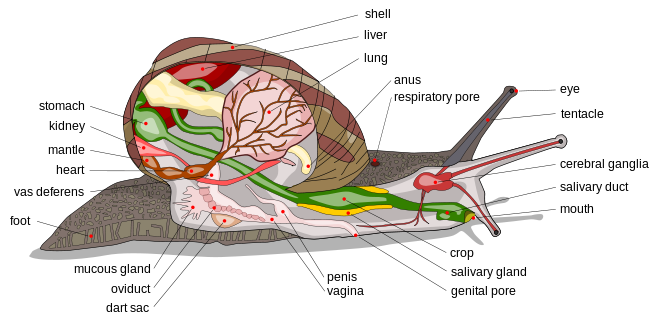Adaptation
Patera leatherwoodi is a terrestrial land snail, so it has experienced many different adaptations throughout it life in order for it to have the capabilities to live out of water. There is little known about the specific changes that Patera leatherwoodi underwent, so this section will be discussing the changes that the class Gastropoda and terrestrial land snails underwent.
According to Avril Bourguin, the largest change
that Gastropods underwent was torsion of their body,
 Bourguin
also describes some of the process of this torsion.
Originally the Gastropods have flat spiraled shells that were
very inconvenient for them to move with, for they were so large.
Some of the Gastropods then, experience a twist of 180
degrees in the counter-clockwise direction, this twist then brought
the mantle cavity, gills and anal opening to be positioned behind
the head. This torsion
now solved the problem of the large symmetrical shell by creating an
asymmetrical coil of the shell.
These coils were now stacked, a new one being added below the
next. The coils are
also aligned along the center axis known as the columella, which is
slightly slanted upwards and backwards, to help compensate for the
weight of the shell (Bourguin, 2002).
Although torsion fixed the problem with shell size, it
created some different problems, including a compression that
resulted in the snails shrinking in size as well as in some cases,
completely losing their gill and kidney on the compressed side of
the body (Bourguin, 2002).
Bourguin
also describes some of the process of this torsion.
Originally the Gastropods have flat spiraled shells that were
very inconvenient for them to move with, for they were so large.
Some of the Gastropods then, experience a twist of 180
degrees in the counter-clockwise direction, this twist then brought
the mantle cavity, gills and anal opening to be positioned behind
the head. This torsion
now solved the problem of the large symmetrical shell by creating an
asymmetrical coil of the shell.
These coils were now stacked, a new one being added below the
next. The coils are
also aligned along the center axis known as the columella, which is
slightly slanted upwards and backwards, to help compensate for the
weight of the shell (Bourguin, 2002).
Although torsion fixed the problem with shell size, it
created some different problems, including a compression that
resulted in the snails shrinking in size as well as in some cases,
completely losing their gill and kidney on the compressed side of
the body (Bourguin, 2002).
The sub class of Pulmonata, kept the trait of the
torsion (Bourguin, 2002), but they also needed to develop a way to
breathe on land. Nordsieck
discusses some reasons as how snails could adapt to terrestrial
life, including saving water and in breathing dry air.
Snails originally used
gills, that have the capability to acquire oxygen from water, but
since the Pulmonates have adapted to live terrestrially, they have
modified their mantles to acquire dry air, creating a lung.
The pulmonates also have a problem of losing water through
exhaling; this problem is taken care of by multiple adaptations.
The task of protecting the snail’s body from too much water
loss is now attributed to the mantle.
The mantle performs its new job by growing into a very thick
tissue. The snails’
have also a ring of muscle that is used to control air flow and
water loss through a respiratory hole, known as the pneomostome (Nordsieck,
2011).
The snails in the order of Stylommatophora have
increased their fields of vision by placing their eyes at the tops
of a second pair of tentacles, known as eye stalks (Nordsieck,
2011). These sensors
are very important to the snails, so all four of its tentacles can
be withdrawn into the snail very quickly (Nordsieck, 2011).
To learn about Patera leatherwoodi's Nutrition click here.